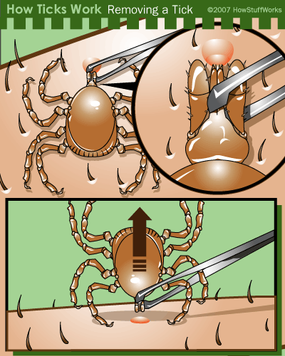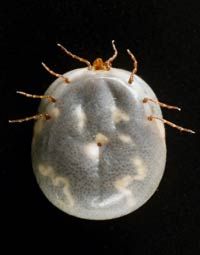Tick Removal
In general, hard ticks take a long time to transmit diseases to people. Some diseases require the tick to be attached for four or more hours. Most Lyme disease infections occur after an infected tick has been attached to its host for more than a day. For this reason, it's important to inspect yourself and your family members for ticks regularly any time you're somewhere ticks are likely to live, including:
- Tall grass
- Dense shrubbery
- Wooded areas
Since tick larvae often wait for hosts at ground level, it's also a good idea to check for them after sitting on the ground. You should also keep an eye out for ticks after bagging leaves or carrying wood.
Advertisement
Since it generally takes four hours for a tick to make you sick, it's a good idea to check for ticks every two to three hours. Pay special attention behind the ears, anywhere that skin, folds and all over the scalp. Keep an eye out for tiny tick nymphs -- nymphs frequently transmit Lyme disease because they're small and hard to notice.
Most of the time, it's also easier to remove ticks before they've spent a lot of time on your body. The longer the tick stays attached, the more swollen its abdomen will be, and the harder it will be to grasp the tick without squeezing it. In addition, the tick's cementlike saliva hardens as the tick feeds, making it harder to remove.

When you find a tick, here's what to do:
- Use a pair of tweezers to grasp the tick where it attaches to the skin. If you spend lots of time in tick-prone areas, it's a good idea to keep one set of tweezers on hand solely for removing ticks. Always disinfect them afterward.
- Pull the tick straight out. Pull slowly and firmly, and do not jerk or twist the tick. Be careful not to squeeze the tick's abdomen.
- Wash the area thoroughly with soap and water.
- If possible, save the tick. It may help doctors make a more accurate diagnosis in case of illness.
If you've heard any old wives' tales about how to remove ticks, chances are they're not a good idea. Applying rubbing alcohol, petroleum jelly, nail polish remover or a lit match will not help you to remove the tick. It's more likely to cause the tick to regurgitate, spreading potentially infective material into the bite.
Although removing ticks promptly can significantly reduce your chances of getting sick, a better strategy is to keep from being bitten at all. Next, we'll look at how to prevent tick bites and control tick populations.
